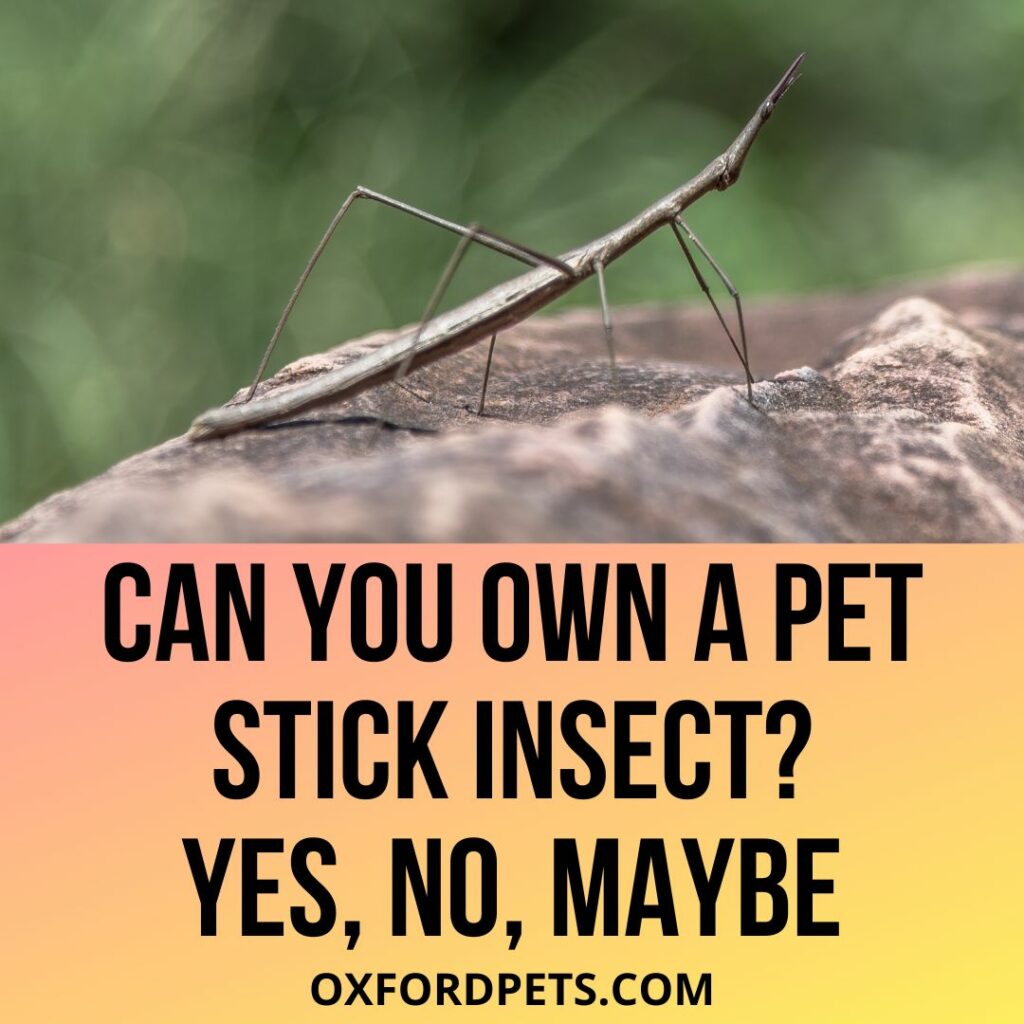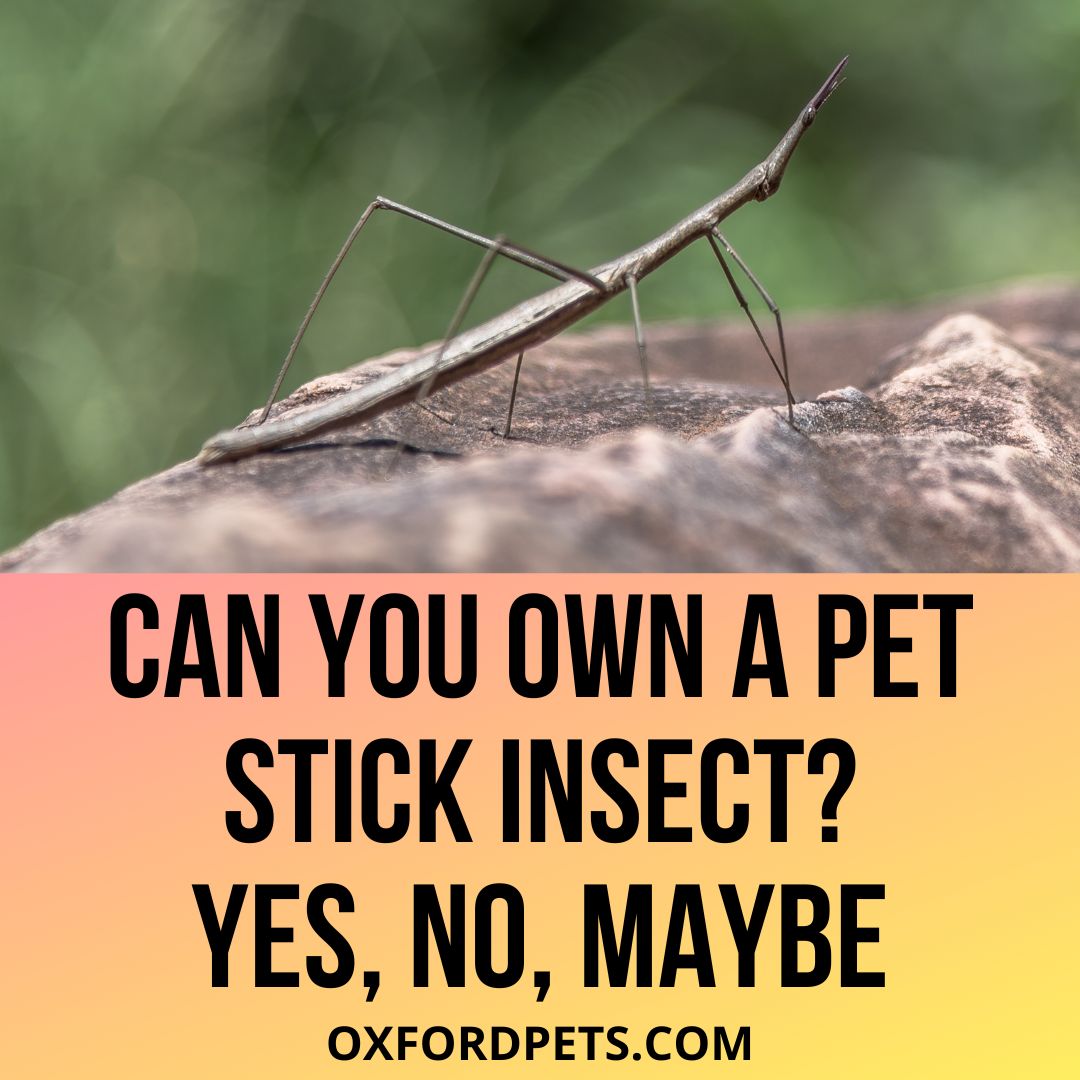Ever seen an Insect as a pet? If you are a pet enthusiast who loves keeping unusual pets or know someone else with a similar hobby, you must definitely know about Stick Insects. Known for their elegant, long-limbed body, Stick Insects are incredible creatures. But are they really meant for domestication?
Well, Stick Insects are common as pets, so it is possible to own them. There are over 3000 species of Stick Insects; however, the Indian Stick Insect is most common in pets. Besides utmost handling care, these creatures require no special treatment. They are quite easy to tame and are the most effortless creature to have around. Even if left without care for a while, Stick Insects can manage their health on their own. Fascinating enough? Come let’s shed some more light on it:
Contents
- Stick Insects: Where Do they Come From?
- Common Stick Insects that are popular as Pets:
- Stick Insect Species Taxonomy/Overview
- Do Stick Insects Make Good Pets?
- Are Stick Insects legal as pets in Australia?
- Australian Stick Insects that are legal in the country:
- Are Stick Insects legal in the U.S.?
- Stick Insect as Pets- All that you might need to know
- Pros and Cons of Stick Insects as pets
- How Much Does a Stick Insect Cost?
- Where To Buy a Stick Insect? Where to find a Stick Insect Breeder?
- Stick Insect Facts for Kids
- Frequently Asked Questions
- Wrapping up…
Stick Insects: Where Do they Come From?
Stick Insects, which are also known as Walking Insects, are one of the most common creatures present across the world. They belong to the Phasmatodea order, and other members of their family are also referred to as Stick animals, Stick bugs or Bug sticks. Due to their natural camouflage, they are difficult to detect by predators. Unless closely observed, even humans can confuse them for a dry stick or leaf.
There are thousands of different Stick Insects present around the world. Members of the Phasmatodea order are present in almost every continent except Antarctica. However, only a few of them are popular and possible as pets.
Common Stick Insects that are popular as Pets:
- Vietnamese or Annam walking stick
- Giant Prickly Stick
- Indian Stick Insect (Most Popular)

Stick Insect Species Taxonomy/Overview
| Name | Stick Insects |
| Other Names | Walking Stick, Leafy Insect, Stick Bug, and more |
| Scientific Names | Phasmatodea |
| Kingdom | Animalia |
| Phylum | Arthropoda |
| Class | Insecta |
| Order Superorder Magnorder | Phasmatodea, Orthopterida, Polyorthoptera |
| Size | Height (Length): (2.5 to 30 cm) long Weight: 25g (0.9oz) for female 12 to 13 g (0.4 to 5oz) for male |
| Lifespan | 8 months to 18 months (Commonly up to 11-12 months) |
Do Stick Insects Make Good Pets?
With correct handling, Stick Insects can make easy and good pets. They are low-maintenance, do not ask for any attention, and can manage independently for the entire time.
Unlike dogs and cats, Stick Insects will rarely cause a ruckus inside the house or would rarely bother someone with their presence. All they need is a small suitable enclosure and some food every 2 to 3 days.
However, their highly delicate build might bring concern when owning a pet Stick Insect. These creatures are so fragile that one can’t even press and hold them between two fingers.
Instead, allowing the insect to settle in your palm is essential. Being extra cautious while handling Stick insects is the key to their long life. A little mishandling, and you might end up killing or hurting the pet.
Are Stick Insects legal as pets in Australia?
Stick Insects are present in a variety of species, and the species of Australian stick and leaf insects are legal in the country.
Any Stick Insect species that is native to the country can be kept as a pet or owned for study purposes.
However, it is illegal to release these creatures into the wildlife. Even throwing their undestroyed eggs into the wild is termed illegal.
Australian Stick Insects that are legal in the country:
- Cigar Stick Insect (Cigarrophasma tessellatum)
- Gargantuan Stick Insect
- Australian Leaf Insect
- Crowned Stick Insect
- Spiny Leaf Insect (Extatosoma tiaratum)
- Stick Insect (Megacrania batesii)
- Goliath Stick Insect (Eurycnema goliath)
Note: Owning a Leaf Insect in many regions of Australia might come with different regulations. Therefore, before adopting or purchasing these creatures, go through your local laws. Some regions might require a specific permit or license to own leaf insects.
Are Stick Insects legal in the U.S.?
Any species of Stick Insect that is non-native to the United States is illegal in the country. Owning, possessing, trading, harming, or releasing them in the wild is strictly restricted. It is because non-native Stick Insects are considered pests in the U.S., and their presence in the wild can prove harmful to the ecosystem.
The U.S. Department of Agriculture restricts the export and import of Stick Insects and other pests under a special permit. Individuals taking the laws lightly might land into deep legal trouble under acts of illegal trafficking.
Stick Insects proliferate easily, and thus even releasing their eggs anywhere is illegal. Pet owners or institutions who by chance own a Stick insect must egg by crushing, boiling, or burning them before disposing of them.
However, individuals in the United States can own Northern walking stick (Diapheromera femorata) as pets. The Northern walking stick is the only native stick insect in the U.S. Though; it is better to consult with your local authorities before since laws can differ in every country, town, and municipality.
Stick Insect as Pets- All that you might need to know
Stick Insect Housing Needs
These Insects are raised in captivity, and an enclosure is vital for their wellbeing.
An enclosure mimicking their natural environment will do the best job. For size, keep the cage at least 15 inches tall, or thrice the length of the insect. Enclosures like tall glass jars, plastic pet containers, and glass tanks do the job well. However, add a well-ventilated yet secured lid instead of vacuuming the enclosure.
Note: Remember, Stick insects are tiny, and they can escape from possibly any given point.
Add dry leaves, small branches, and other natural features inside the enclosure. It is important to replicate their natural habitat, or your pet Stick Insect might find it difficult to thrive.
Stick Insect Temperature and Humidity Needs
Stick Insects majorly thrive in warmer environments. Consider keeping the temperature of their enclosure around 70 to 75 degrees Fahrenheit. Keeping the enclosure in any warm room will do the job. Though in any case, do not allow the temperature to drop below 60 degrees Fahrenheit or the poor insect may die.
Individuals who live in cold places can use heating pads or artificial heating techniques to maintain the temperature. With heating lamps, use only red or blue colored bulbs as white bulbs aren’t suitable for nocturnal animals, especially during nighttime.
Besides that, maintain humidity levels at 70% to 75%. Lack of humidity will increase shedding in Stick Insects. Along with that, regular misting is highly advisable. However, with misting, keep an eye on ventilation as well, or it might lead to fungus or mold accumulation.
Stick Insect Dietary Needs
Stick Insects eat twice or thrice a week, but their diet is quite specific. They prefer feeding on oak, rose, ivy, privet, bramble, and hawthorn leaves. However, anything in your pet Stick Insect’s diet should be fresh and free of insecticides and herbicides.
Avoid going for any random leaves and branches you find in your backyard or garden.
Stick Insect Cleaning Needs
Stick Insects require no bathing or grooming, but daily misting is a must.
Besides that, consider cleaning their enclosure once every week. Remove all the dirt and especially look out for any fungal growth inside the enclosure. Also, remove all the uneaten food every 2 to 3 days.
Common Health Problems with Stick Insects
Stick Insects are one of the easy-to-keep pets, ideally because of their least exposure to health issues. Besides shedding their skin, they would be less likely to undergo any physical changes.
However, in some rare cases, pet Stick Insects might suffer from fungal infection or pesticide exposure. Both of these conditions can lead to death amongst the insects.
Pros and Cons of Stick Insects as pets
Keeping a pet comes with its own set of benefits and drawbacks. Similar is the case with pets like Stick Insects. Here is a quick look into the same:
Advantages of pet Stick Insects
- They are easy to care for.
- They are affordable, and even keeping them does not require spending much.
- They eat twice or thrice a week, meaning less effort and food expenses.
- It is extremely rare for Stick Insects to catch any illness.
- They are docile and easy to tame.
- Stick Insects can’t and won’t harm/ attack humans.
- They are friendly and will sit on your hands.
- They have a short lifespan which means no long-term commitment.
Disadvantages of pet Stick Insects
- You can’t cuddle them.
- Handling a Stick Insect requires extreme caution, or you might end up breaking them.
- They are nocturnal, and it is less likely to see them very active during light hours.
- Stick Insects are boring pets.
- They can prove dangerous for your local ecology.
How Much Does a Stick Insect Cost?
A supply of 40 to 50 Stick Insects costs anywhere between $20 and $50. The price may vary depending upon the species of Stick Insect you are purchasing.
Besides that, their initial setup cost would fall between $150 to $400. In contrast, their yearly maintenance would cost no more than $60 to $70.
Where To Buy a Stick Insect? Where to find a Stick Insect Breeder?
Stick Insects are easily available at pet shops or online through reptile supply vendors.
In States where Stick Insects are legal, you may find Breeder, though they may be less likely to sell a single insect.
Stick Insect Facts for Kids
- Stick Insects are found on every continent except Antarctica.
- Currently, there are over 3,000 different species.
- Stick insects are absolutely weightless, though the females are heavier than the males.
- Most Stick insects are commonly black, brown, and green in color. However, it is possible to find them in different color combinations.
- Most Stick Insects live no more than 8 to 10 months. However, a few of them may also live up to 2 years.
- They are one of the longest pests present around the world.
- Stick Insects can Regenerate their limbs.
- Stick Insects can easily reproduce without their male partner.
- Stick Insects aren’t defenseless.
- Stick Insects are known for playing dead.
Frequently Asked Questions
Do Stick Insects like being handled?
Stick Insects aren’t very likely to catch feelings, though they won’t mind being handled. While handling, most of them would likely walk around in your hand or jump on your other body parts.
Are Stick Insects venomous?
Stick Insects aren’t venomous, but if felt threatened, they might sting. However, their bite poses no harm to humans.
Can two stick insects live together?
Many species of stick insects are easy to be kept together. However, because they multiply quite quickly, it is better to house only one as a pet. If not given enough space, stick insects even might end up eating each other.
Wrapping up…
Can you have Stick Insects as pets? Yes, if Stick Insects are legal in your area, you can undoubtedly have them as pets. Check state and federal regulations, especially if you are targeting a non-native species. After doing some basic research, Stick Insects will prove an easy pet for your home.
